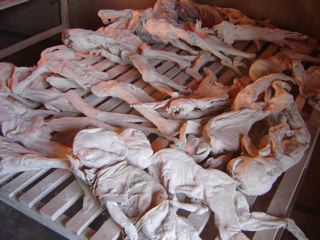Kony (2012- )
So I finally watched the Kony 2012 video that everyone is talking about (http://www.youtube.com/watch?v=Y4MnpzG5Sqc ). This is a video put out by the NGO, InvisibleChildren.com, which urges all people, especially young people to learn about a man named Kony in Uganda, then work with the organization in three concrete ways to get him killed
Great Anti-Kony Ad Campaign
It’s an interesting campaign. Usually, NGO’s ask for money to buy children a primary education, a farmer seeds, or a baby vaccines. But this campaign asks a donor to take a life to save lives. As supporters of Invisible Children might point out, this is not a new strategy for governments: Bin Laden and the war on terror. Saddam and weapons of mass destruction. Charles Taylor and blood diamonds. But NGO does stand for non-governmental organization and as a rule they work to capacitate citizens with pens and sowing implements rather than soldiers with radars and guns. Call it a division of labor. Call it making love not war.
Kony is a bad guy by all accounts. He has kidnapped children in Uganda to fight an insurgent war across three countries through his Lord’s Resistance Army (LRA). To intimidate his recruits against running away after abducting them, he makes them witness or perpetrate the rape of family members, the murdering of parents, the mutilation of faces and genitalia, the eating of human body parts, in effect, shaming young teens into an exile of violent and despicable acts. It is unclear from Kony 2012 why Kony is doing all of this but the consequences of the acts are clearly communicated through professionally produced heart-felt images and the story of Jacob, a boy who escaped Kony but not before witnessing his brother’s murder by having his neck slashed open. By the end of the video, it is very clear that Kony is a problem that must go away.
The video doesn’t mention Museveni, the current President of Uganda who has been in power since 1986. This is unfortunate because mention of Museveni would acknowledge that all acts take place in a context and that acts are more meaningful when described relative to historical and contemporary events, culture and figures. The story of Museveni is that for decades he has refused to relinquish power, recently even changing the Ugandan constitution to allow him to rule in perpetuity. Museveni’s positive is that he values education. His negative is that he also employs the policy position of making political opponents disappear. Museveni’s People’s Defense Force (UPDF) has been fighting Kony’s LRA since 1987. Invisible Children asks in the video Kony 2012 to help the UPDF locate Kony (for killing) by making available to them American military consultants (for killing). In other words, Invisible Children asks citizens from around the world to increase the power of the UPDF because of a common enemy, the LRA, in disregard to the UPDF’s own human rights abuses.
Rwandan Genocide-- inaction has consequences
The third part of story does little to clarify the situation. It was the UPDF who trained and armed the Rwandan Liberation Front (RLF) in the 80’s and 90’s. The RLF is the army that single-handedly ended the genocide of a million Tutsi’s in 1994 in neighboring Rwanda while the United States under Clinton and the United Nations under Kofi Annan stood by. Paul Kagami was the brave RLF general who is now the president of what is arguably the most peaceful, non-corrupt and beautiful country in Africa. I lived in Rwanda and can attest that even if you are a Hutu murderer, Kigami is a God-send, who has developed the country’s economy while miraculously preventing the expected violent retribution following 90% of the population attacking with machete the minority 10%. So, the UPDF force that is keeping Museveni the dictator in power in Uganda is also a force for good.
The problem I have with the Invisible Children movement is not about getting people to act, because people should act on behalf of people less fortunate than themselves wherever they are; not with creating a polished advertisement for international aid, because NGO’s really do need to start replacing the same old fly covered skeleton empty bowl story with 21st century symbols along 21st century networks; not even with a simplistic one-two-three punch strategy of making a difference. Kudos to anyone who can help individuals figure out a way to contribute in this electronically connected paradoxically isolated world. My problem with Kony 2012 is that it is that it is only Kony 2012. With Kony stands Kabila, Kim Jung-un, Kabila, Mugabe, Putin, al-Bashir, Museveni, and Ahmandinejad. What about them? The urgency of getting it all done by 2012 masks root issues that allowed the LRA to acquire power in the first place, which will persist even after 2012. Unless addressed who among us could not imagine a Kony or Konia II or III?
The solution must be more long term and it would be great to see a shock and awe campaign like Kony 2012 communicating how justice is a drawn-out, worthy fulfilling fight. Such a campaign may include eliminating despots like Kony, but must not ignore long-term investments like the building of farms, schools and bridges too. To me, the Invisible Children campaign should be called Visible Children (2012 - ). Every child, aided by the world’s citizens, does deserve to be seen and urgently. But this takes the commitment of time, lest the vision go away in an electronic blink.
Haitian children outside port-au-prince refugee camp, April 2010






